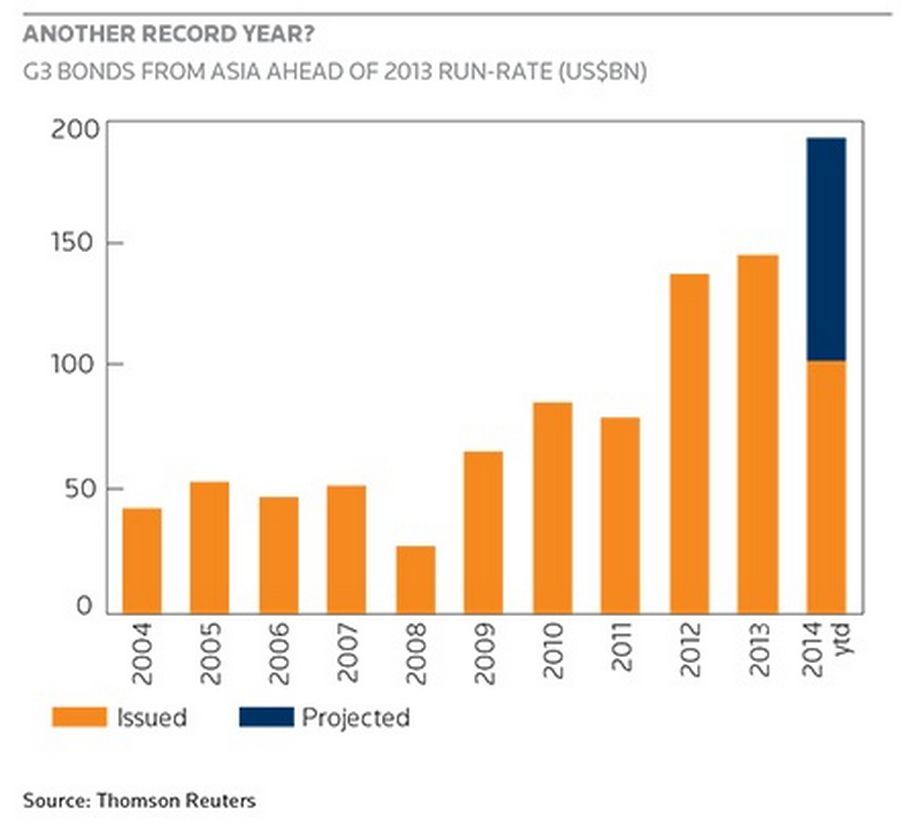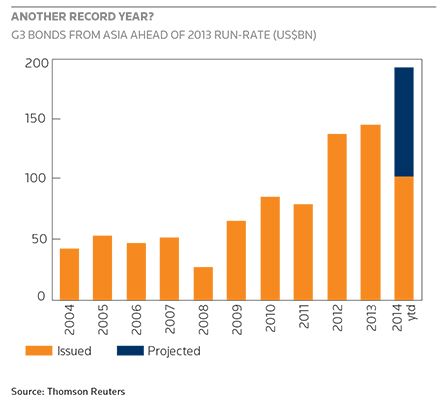Asia’s bond markets continue to develop rapidly, with international sales again running at a record pace, despite the looming threat of interest-rate hikes.

Growing stronger
Source: REUTERS/Donald Chan
A Shaolin student guides a Swiss girl of Chinese origin during a campaign to promote kung fu at the Shaolin Temple in Dengfeng, Henan Province.
Asia’s offshore bond markets have grown steadily for much of the last decade and are on track for their best year on record. However, there are increasing worries that what appears to be secular broadening and deepening of Asia’s credit markets is actually a bubble, stemming from the US Federal Reserve’s easy money policies, particularly its massive bond-buying programme, known as quantitative easing.
“It’s been as good as it gets for pretty much everyone since QE3 kicked off,” said the head of DCM at a European bank in Hong Kong.
“US rates have continued to fall and spreads have tightened, so issuers have had a great time and end users have seen capital appreciation,” the DCM head said. “The issue now is just how the markets will deal with the normalisation of Fed policy in the face of an economic recovery.”
Since the Federal Reserve began its third round of QE in September 2012, short-term US dollar rates, Treasury yields and credit spreads across the dollar-debt spectrum from high grade to high yield have declined. Before the financial crisis, the Fed owned US$800bn–$900bn; now it sits on US$4trn. In the process, the US dollar markets have gone through the lowest sustained rate environment in history.
Investors set off on a “global quest for yield”, which underpinned the market for more than two years. In Asia, US and European investors have been willing to put in credit work on unfamiliar names and new structures in their desire to book yields.
The Fed’s aggressive bond-buying scheme has delivered what it set out to achieve on various measures: US growth has picked up and the country’s employment has recovered in nominal terms without any consequent inflationary pressure.
Yet, some worry it has done so at a cost.
“These vast flows of capital have gone up the risk curve and created what may well have been excesses, that now, as we know, are tending to unravel, and that has a destabilising effect,” said former US Treasury Secretary Robert Rubin in a March address at the University of Chicago Booth School of Business.
Wild growth
Any worries have yet to affect Asia’s bond markets. G3 issuance from Asia ex-Australia ex-Japan in 2014 so far totals the equivalent of US$100bn, according to Thomson Reuters. Last year’s total was US$142bn. If the current pace is maintained, G3 bond sales from Asia could, in theory, reach US$200bn, up 25% on last year’s total.
The growth of the offshore bond market in Asia has been staggering. From US$41.6bn-equivalent in 2004, the market hit US$49bn in 2007 before falling to US$26.3bn during the financial crisis. However, volumes returned, reaching US$64.9bn in 2009 and US$134bn in 2012. If this pace continues, the market for offshore primary debt in Asia will have grown five-fold in a decade.
Fed policies clearly spurred Asia’s bond market growth, but a drop in bank lending also contributed as international banks scaled back lending amid the global financial crisis. The Greek financial crisis, in particular, prompted European banks to pull capital out of Asia’s loan markets. Also, Japanese banks have been stingy.
Asian issuers still prefer to tap the US market for offshore funding, although local bond markets also are surging, thanks to investors flush with cash. In addition, euro issuance is picking up and now accounts for about 12% of primary debt originated out of Asia.
China, long the region’s economic powerhouse, has finally become its largest issuer in the public offshore bond markets. Chinese borrowers were behind US$13.6bn of the record US$27.1bn sold in Asia’s G3 markets in April. South Korea is also one of Asia’s G3 staples, principally of investment-grade bonds, with policy banks Korea Development Bank and Export-Import Bank of Korea the dominant players.
“If you compare each region’s GDP footprint one can argue that Asia has been under-represented in the capital markets and is only now punching at its weight so the issuance pace of the past five years or so from Asia can continue.”
China’s signature issuance this year has been the jumbo trade, often multi-tranched and originating from the country’s ambitious state-owned enterprises, or SOEs. China Petrochemical Corp, or Sinopec, issued a US$5bn five-tranche bond in early April and, as a result of heady demand, was able to print tighter than its implied curve at all tenor points.
Perhaps that was a measure of how frothy Asia’s G3 arena had become. At the end of April, cracks were beginning to show. China National Offshore Oil Corp, or CNOOC, needed to offer a new-issue concession to sell a US$2.25bn 10-year bond, the biggest single-tranche offering out of Asia.
CNOOC’s struggles were viewed as a signal that the “Goldilocks” conditions of the first half – a combination of low US rates, plenty of cash from real-money accounts, and plentiful supply – were waning.
Those conditions allowed issuers, such as the Republic of Indonesia, to complete much of their annual funding needs. Indonesia sold a US$4bn two-part bond in January and is not expected to revisit the straight dollar market this year, having mandated banks to work instead on a sukuk and a euro-denominated bond.
Changing rates
US interest rates are not heading north just yet, but market participants have their eyes on data points, such as rising US consumer prices and surging oil prices in the wake of fighting in Iraq. A renewed major conflict in Iraq, which produces 3% of the world’s oil, could add to global inflation rates, in turn, forcing central banks to push up interest rates, with the Fed leading the way.
Fed chair Janet Yellen has asserted that US interest rates will remain low until the US unemployment rate hits its long-term average of 5.5%, but such are the markets: rising inflation is often the result of external shocks and one of the toughest data points for central banks to predict or control without killing economic growth.
Rising rates could lead to a drastically different issuance environment in Asia.
“The market had a taste of what tighter Fed policy would mean in May last year when talk of QE3 easing was first mentioned,” the DCM head said. “It sent spreads rocketing up and shut the issuance window for EM names for a few months. That risk hasn’t gone away and we could be in for some volatility of that sort again should it look as if the Fed needs to switch policy to tightening.”
Many borrowers have anticipated rising rates and taken advantage of investor appetite for yields to sell bond in large sizes and with riskier structures. Loss-absorbing bank capital bonds have had little trouble finding buyers as has unrated corporate hybrid paper.
Should volatility return with a vengeance, some of the riskier bonds could be marked down several points. Market bears believe it could lead to a major re-rating of the high-risk end of the market, making it difficult for loosely structured, high-yield bonds to return.

Growing stronger_Chart
No doubt, demand for Asia’s higher yielding bonds is likely to continue.
“An aging demographic has prompted a focus among insurers and pension funds on high-dividend stocks and high-yielding debt, forcing them to extend duration and/or go down the credit curve,” said Herman van den Wall Bake, head of Asia debt capital markets at Deutsche Bank in Singapore.
“As a result, the differential between subordinated and senior debt yields has contracted,” van den Wall Bake said. “Nevertheless Asian offshore debt looks cheap in relation to similarly rated credits in Europe or the US, two regions where spreads have compressed even further.”
Among emerging-market credits, Asia historically has accounted for a smaller share than EMEA and has been roughly on par with Latin America. That gives room for Asia to grow despite the already brisk pace of recent years.
“If you compare each region’s GDP footprint one can argue that Asia has been under-represented in the capital markets and is only now punching at its weight so the issuance pace of the past five years or so from Asia can continue,” van den Wall Bake said.
One key element of the market’s future performance will be the ability of the Fed to cut its balance sheet without causing a major market disruption.
Offloading the trillions of dollars of US Treasury debt – representing 22% of US GDP – will be an unprecedented action that essentially means the Fed is, in the words of one Singapore syndicate head, “boldly going where no central bank has gone before”.
This unnerving backdrop has had little effect on either the primary or secondary markets. The benchmark iTraxx IG Index, a measure of credit default risk in outstanding bonds, continues to trade around the 100bp mark, close to its all-time low.
Investors also remain willing to embrace high-beta low-grade names across a variety of asset classes, including China property names and perpetuals. This strategy may be sternly tested in the months ahead.
To see the digital version of this report, please click here.

